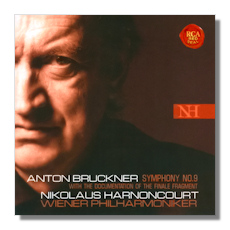
The Internet's Premier Classical Music Source
Related Links
- Bruckner Reviews
- Latest Reviews
- More Reviews
-
By Composer
-
Collections
DVD & Blu-ray
Books
Concert Reviews
Articles/Interviews
Software
Audio
Search Amazon
Recommended Links
Site News
 SACD Review
SACD Review
Anton Bruckner

Symphony #9
- With documentation of the finale fragment
Vienna Philharmonic Orchestra/Nikolaus Harnoncourt
RCA Red Seal 82876-54332-2 CD+SACD
There are two discs on this release. The first disc features two versions (in German and English respectively) of a workshop concert in which Harnoncourt introduces and conducts John A. Philipps's edition of the finale of Bruckner's 9th Symphony. The second disc, an SACD, features a live recording of the "standard" 9th symphony from August 2002.
By the time of Bruckner's death, we learn from Harnoncourt and from the detailed liner notes, he had completed composing the finale, but was unable to complete the instrumentation. Some portions exist in their entirety, in particular the whole of the exposition. In some the final instrumentation remains incomplete. And, although there appears to have existed a fully paginated autograph score, a number of pages have disappeared.
The lengthy fragment that remains (around 18 minutes of music) is tantalizing. It contains some of Bruckner's most dissonant and forward-looking music (as Harnoncourt puts it, Bruckner dropped into the musical world like a stone from the moon), as well as another of his wonderful fugues. Tragically nothing remains of the coda in which Bruckner recapitulated key themes from the 5th, 7th, and 8th movements. But there is enough preserved to make clear that Bruckner envisaged the finale as the summa of his symphonic odyssey.
So now Bruckner-lovers and performers have a real puzzle. On the one hand, the remains of the finale are too fragmented to be performed after the three movements that have been preserved in their entirety. On the other, the standard picture of the Adagio being Bruckner's apotheosis and farewell to life seems demonstrably mistaken.
This has performance implications, most obviously for how the Adagio is approached. Comparing them side by side reveals Harnoncourt to be much more understated than, say, Gunter Wand. Harnoncourt approaches the opening bars with much weaker dynamical contrast, for example. And the Adagio's massively discordant climax is less monumental for Harnoncourt than it is for Wand (and many others).
Of course that's exacting what one would expect when the Adagio is viewed as the third of four movements, rather than as a cathartic finale. But the downside is that the 4th movement doesn't really exist, and so to structure the Adagio in the light of it may be to compromise its greatness without adding audible benefits.
Nonetheless, Harnoncourt has done a valuable service by dispelling some persistent myths about the 9th symphony, and shedding new light on Bruckner's final statement. It will be hard for anyone who listens to this lengthy fragment to hear the standard three-movement version in the same way again.
Copyright © 2012, José Luis Bermúdez





















